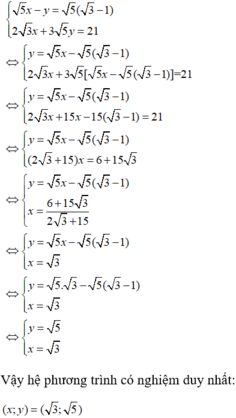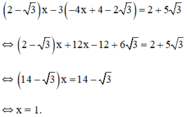

Hãy nhập câu hỏi của bạn vào đây, nếu là tài khoản VIP, bạn sẽ được ưu tiên trả lời.



Làm mẫu hai câu a, b thôi nha.
a, \(\left\{{}\begin{matrix}x-\sqrt{3}y=0\\\sqrt{3}x+2y=1+\sqrt{3}\end{matrix}\right.\)
\(\Leftrightarrow\left\{{}\begin{matrix}x=\sqrt{3}y\\\sqrt{3}.\sqrt{3}y+2y=1+\sqrt{3}\end{matrix}\right.\)
\(\Leftrightarrow\left\{{}\begin{matrix}x=\sqrt{3}y\\5y=1+\sqrt{3}\end{matrix}\right.\)
\(\Leftrightarrow\left\{{}\begin{matrix}x=\dfrac{\sqrt{3}+3}{5}\\y=\dfrac{1+\sqrt{3}}{5}\end{matrix}\right.\)
\(\Leftrightarrow\left\{{}\begin{matrix}x\approx0,95\\y\approx0,55\end{matrix}\right.\)
b, \(\left\{{}\begin{matrix}\sqrt{2}x-\sqrt{5}y=1\\x+\sqrt{5}y=\sqrt{2}\end{matrix}\right.\)
\(\Leftrightarrow\left\{{}\begin{matrix}\sqrt{2}\left(\sqrt{2}-\sqrt{5}y\right)-\sqrt{5}y=1\\x=\sqrt{2}-\sqrt{5}y\end{matrix}\right.\)
\(\Leftrightarrow\left\{{}\begin{matrix}2-\sqrt{5}\left(\sqrt{2}+1\right)y=1\\x=\sqrt{2}-\sqrt{5}y\end{matrix}\right.\)
\(\Leftrightarrow\left\{{}\begin{matrix}y=\dfrac{\sqrt{2}-1}{\sqrt{5}}\\x=1\end{matrix}\right.\)
\(\Leftrightarrow\left\{{}\begin{matrix}y\approx0,19\\x=1\end{matrix}\right.\)

a) \(\left\{{}\begin{matrix}x-\sqrt{3}y=0\\\sqrt{3}x+2y=1+\sqrt{3}\end{matrix}\right.\Leftrightarrow\left\{{}\begin{matrix}\sqrt{3}x-3y=0\\\sqrt{3}x+2y=1+\sqrt{3}\end{matrix}\right.\)
Lấy phương trình dưới trừ phương trình trên thu được: \(5y=1+\sqrt{3}\Rightarrow y=\dfrac{1+\sqrt{3}}{5}\Rightarrow x=\sqrt{3}y=\dfrac{3+\sqrt{3}}{5}\)
b) Cộng hai phương trình lại với nhau thu được:
\(\left(\sqrt{2}+1\right)x=\sqrt{2}+1\Leftrightarrow x=1\Rightarrow y=\dfrac{\sqrt{2}-1}{\sqrt{5}}\)
c) \(\left\{{}\begin{matrix}\sqrt{2}x+\sqrt{5}y=2\\x+\sqrt{5}y=2\end{matrix}\right.\)
Lấy phương trình trên trừ phương trình dưới:
\(\left(\sqrt{2}-1\right)x=0\Leftrightarrow x=0\Rightarrow y=\dfrac{2-x}{\sqrt{5}}=\dfrac{2}{\sqrt{5}}\)
d) Hướng dẫn. Nhân phương trình đầu với \(\sqrt{2}\) rồi lấy phương trình thu được trừ phương trình dưới.

Bài toán giải hệ phương trình bằng phương pháp thế có 2 cách trình bày.
Cách 1:

Từ (1) ta rút ra được x = -y√5 (*)
Thế (*) vào phương trình (2) ta được :

Thay y = 5 - 1 2 vào (*) ta được: x = − 5 − 1 2 ⋅ 5 = 5 − 5 2
Vậy hệ phương trình có nghiệm 5 − 5 2 ; 5 − 1 2

Từ (2) ta rút ra được y = -4x + 4 - 2 √3 (*)
Thế (*) vào phương trình (1) ta được:

Thay x = 1 vào (*) ta được y = -4.1 + 4 - 2√3 = -2√3
Vậy hệ phương trình có nghiệm duy nhất (1; -2√3)
Cách 2 :

Vậy hệ phương trình có nghiệm duy nhất 5 − 5 2 ; 5 − 1 2

Vậy hệ phương trình có nghiệm duy nhất (1; -2√3)
Kiến thức áp dụng
Giải hệ phương trình  ta làm như sau:
ta làm như sau:
Bước 1: Từ một phương trình (coi là phương trình thứ nhất), ta biểu diễn x theo y (hoặc y theo x) ta được phương trình (*). Sau đó, ta thế (*) vào phương trình thứ hai để được một phương trình mới ( chỉ còn một ẩn).
Bước 2: Dùng phương trình mới ấy thay thế cho phương trình thứ hai, phương trình (*) thay thế cho phương trình thứ nhất của hệ ta được hệ phương trình mới tương đương .
Bước 3: Giải hệ phương trình mới ta tìm được nghiệm của hệ phương trình.

\(\frac{1}{x-3}=a,\frac{1}{y-4}=b\)
\(hpt\Leftrightarrow\hept{\begin{cases}a+b=\frac{5}{3}\\4a-3b=\frac{3}{2}\end{cases}\Rightarrow\hept{\begin{cases}a=\frac{13}{14}\\b=\frac{31}{42}\end{cases}\Rightarrow}}\hept{\begin{cases}x=\frac{53}{13}\\y=\frac{166}{31}\end{cases}}\)

Bài 1:
Đặt \(\hept{\begin{cases}S=x+y\\P=xy\end{cases}}\) hpt thành:
\(\hept{\begin{cases}S^2-P=3\\S+P=9\end{cases}}\)\(\Leftrightarrow\hept{\begin{cases}S^2-P=3\\S=9-P\end{cases}}\Leftrightarrow\left(9-P\right)^2-P=3\)
\(\Leftrightarrow\orbr{\begin{cases}P=6\Rightarrow S=3\\P=13\Rightarrow S=-4\end{cases}}\).Thay 2 trường hợp S và P vào ta tìm dc
\(\hept{\begin{cases}x=3\\y=0\end{cases}}\)và\(\hept{\begin{cases}x=0\\y=3\end{cases}}\)
Câu 3: ĐK: \(x\ge0\)
Ta thấy \(x-\sqrt{x-1}=0\Rightarrow x=\sqrt{x-1}\Rightarrow x^2-x+1=0\) (Vô lý), vì thế \(x-\sqrt{x-1}\ne0.\)
Khi đó \(pt\Leftrightarrow\frac{3\left[x^2-\left(x-1\right)\right]}{x+\sqrt{x-1}}=x+\sqrt{x-1}\Rightarrow3\left(x-\sqrt{x-1}\right)=x+\sqrt{x-1}\)
\(\Rightarrow2x-4\sqrt{x-1}=0\)
Đặt \(\sqrt{x-1}=t\Rightarrow x=t^2+1\Rightarrow2\left(t^2+1\right)-4t=0\Rightarrow t=1\Rightarrow x=2\left(tm\right)\)

<=>\(\hept{\begin{cases}x^3+y^3=1\\x^2\left(x^3-1\right)+y^2\left(y^3-1\right)=0\end{cases}}\)
<=>\(\hept{\begin{cases}x^3+y^3=1\\x^2y^3+x^3y^2=0\end{cases}}\)
Đặt S=x+y;P=xy
khi đó: \(\hept{\begin{cases}S^3-3SP=1\\P^2S=0\end{cases}}\)
sau đó giải hệ pt . kết wa là (0;1);(1:0)

a) Ta có: \(\left\{{}\begin{matrix}-x+2y=3\\3x+y=-1\end{matrix}\right.\)
\(\Leftrightarrow\left\{{}\begin{matrix}-3x+6y=9\\3x+y=-1\end{matrix}\right.\Leftrightarrow\left\{{}\begin{matrix}7y=8\\-x+2y=3\end{matrix}\right.\)
\(\Leftrightarrow\left\{{}\begin{matrix}y=\dfrac{8}{7}\\-x=3-2y=3-2\cdot\dfrac{8}{7}=\dfrac{5}{7}\end{matrix}\right.\)
hay \(\left\{{}\begin{matrix}x=-\dfrac{5}{7}\\y=\dfrac{8}{7}\end{matrix}\right.\)
Vậy: Hệ phương trình có nghiệm duy nhất là \(\left\{{}\begin{matrix}x=-\dfrac{5}{7}\\y=\dfrac{8}{7}\end{matrix}\right.\)
b) Ta có: \(\left\{{}\begin{matrix}2x+2\sqrt{3}\cdot y=1\\\sqrt{3}x+2y=-5\end{matrix}\right.\)
\(\Leftrightarrow\left\{{}\begin{matrix}2\sqrt{3}x+6y=\sqrt{3}\\2\sqrt{3}x+4y=-10\end{matrix}\right.\)
\(\Leftrightarrow\left\{{}\begin{matrix}2y=\sqrt{3}+10\\\sqrt{3}x+2y=-5\end{matrix}\right.\)
\(\Leftrightarrow\left\{{}\begin{matrix}y=\dfrac{\sqrt{3}+10}{2}\\x\sqrt{3}+2\cdot\dfrac{\sqrt{3}+10}{2}=-5\end{matrix}\right.\)
\(\Leftrightarrow\left\{{}\begin{matrix}y=\dfrac{\sqrt{3}+10}{2}\\x\sqrt{3}=-5-\sqrt{3}-10=-15-\sqrt{3}\end{matrix}\right.\)
hay \(\left\{{}\begin{matrix}x=-1-5\sqrt{3}\\y=\dfrac{\sqrt{3}+10}{2}\end{matrix}\right.\)
Vậy: Hệ phương trình có nghiệm duy nhất là \(\left\{{}\begin{matrix}x=-1-5\sqrt{3}\\y=\dfrac{\sqrt{3}+10}{2}\end{matrix}\right.\)

Đặt m = 1 / x - 3 và n = 1/y - 4
Khi đó ta có hệ m + n = 5/3
4 x x - 3 x n = 3/2
....Bạn tự giải tiếp nhé